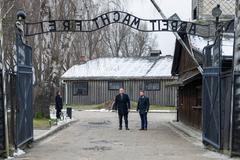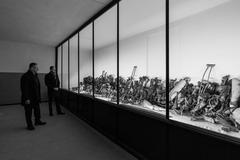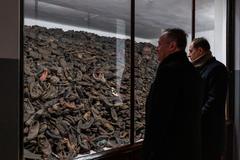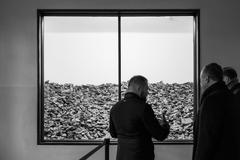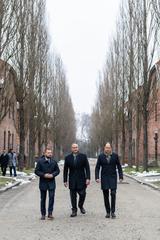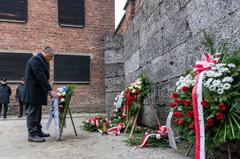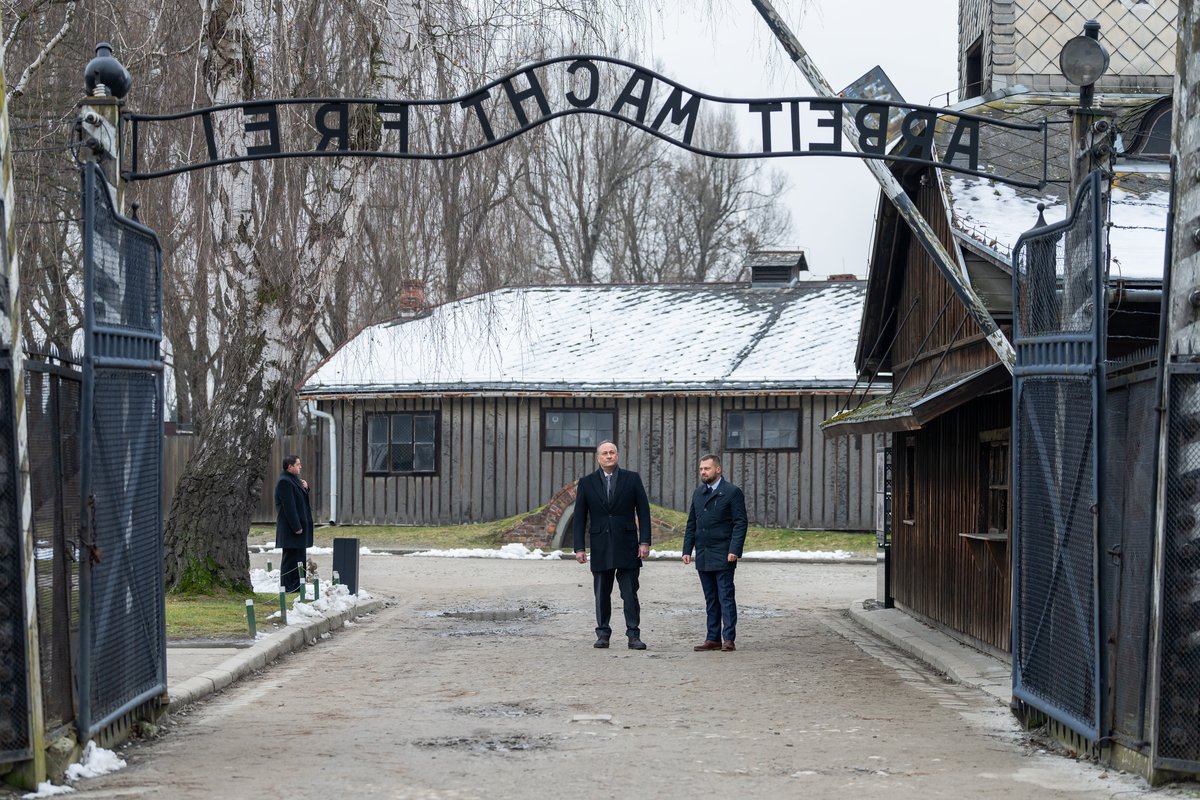
Auschwitz-Birkenau State Museum: Visiting Hours, Tickets, and History Guide
Date: 03/07/2025
Introduction
The Auschwitz-Birkenau State Museum in Oświęcim, Poland, stands as one of the world’s most solemn memorials, commemorating the victims of the Holocaust. Once a vibrant town with a rich Jewish heritage, Oświęcim was transformed during World War II into the site of the largest Nazi concentration and extermination camp complex. Auschwitz-Birkenau is both a powerful symbol of historical atrocities and a place dedicated to remembrance, education, and the ongoing mission to ensure that such horrors are never repeated (mjhnyc.org, aboutholocaust.org, auschwitz.org).
This guide provides essential information for a respectful, meaningful visit—covering historical context, practical travel tips, ticketing, visitor conduct, accessibility, and resources for further education. Whether you are planning your first visit or seeking to deepen your understanding, use this resource to honor the memory of the over 1.1 million victims and engage thoughtfully with the site’s enduring legacy.
Historical Context and Significance
Oświęcim Before and During Nazi Occupation
Before the war, Oświęcim was a typical Polish town with a significant Jewish community, dating back to the early 16th century (auschwitztoursfromwarsaw.com). Its strategic location and railway hub contributed to its industrial and cultural vitality. After the Nazi invasion in 1939, the town was annexed and renamed “Auschwitz,” marking the beginning of a catastrophic transformation (beyondmydoor.com).
The Auschwitz-Birkenau Camp Complex
In 1940, the Nazis established the first camp, Auschwitz I, which expanded into a network including Auschwitz II-Birkenau (the largest and deadliest, functioning as both concentration and extermination camp) and Auschwitz III-Monowitz (a labor camp for German industry) (aboutholocaust.org). Between 1940 and 1945, at least 1.3 million people were deported here; more than 1.1 million, mostly Jews, were murdered, alongside tens of thousands of Poles, Roma, and Soviet prisoners of war.
Today, the museum preserves the memory of these victims, offering a space for reflection, education, and a warning to future generations (mjhnyc.org).
Visiting Information: Hours, Tickets, and Tours
Opening Hours (2025)
- January, November, December: 8:00 AM – 3:00 PM
- February: 8:00 AM – 4:00 PM
- March, October: 8:00 AM – 5:00 PM
- April, May, September: 8:00 AM – 6:00 PM
- June, July, August: 8:00 AM – 7:00 PM
Closed: January 1, December 25, and Easter Sunday (theauschwitz.tours).
Recommended Duration: Allow 3.5–4 hours for both Auschwitz I and Birkenau. Visitors traveling from Kraków should plan for a full day, including transit (traversewithtaylor.com).
Tickets and Reservations
- Advance Booking: All visitors must reserve tickets in advance online; walk-ins are not permitted due to high demand (visit.auschwitz.org, theauschwitz.tours, auschwitztrip.com).
- Ticket Types:
- Individual timed entry (free, but reservation required)
- Guided tours (fee applies; available in multiple languages)
- Audio guides (available for self-guided visits)
- Identification: Tickets are personalized and non-transferable; bring valid ID.
- Children: Not recommended for children under 14 due to the emotional content.
Guided Tours
Guided tours are strongly recommended for context and respectful navigation of the site. Group and private tours are available and can be booked via the official website or authorized operators. Thematic and virtual tours also offer specialized perspectives (theauschwitz.tours, auschwitztrip.com).
Entry and Security
- Arrive at least 30 minutes before your scheduled entry.
- Security screening is required; only small bags (max. 30x20x10 cm) are permitted. A paid luggage hold is available (traversewithtaylor.com).
- Food, large bags, strollers, and pets are not allowed inside the museum.
Accessibility, Facilities, and Practical Tips
Accessibility
- The site is partially accessible for those with mobility challenges; wheelchairs are available free of charge. Some buildings have steps or narrow passages, but staff are trained to assist (auschwitztrip.com).
- Restrooms and information points are available; bring coins for paid toilets (traversewithtaylor.com).
- Facilities are intentionally minimal to preserve a contemplative environment.
Transportation and Getting There
- By Car: Around 1.5 hours drive from Kraków; paid parking nearby.
- By Train: Trains run from Kraków to Oświęcim; museum is 2 km from station (taxi/bus available).
- By Bus: Frequent direct buses from Kraków main station.
- Organized Tours: Many options offer transport bundled with guided tours (traversewithtaylor.com).
- On-Site Shuttle: Free shuttle bus every 10–30 minutes between Auschwitz I and Birkenau (redfedoradiary.com).
Dress Code and Weather
- Wear modest, sober clothing; avoid bright or revealing attire (auschwitztrip.com).
- Comfortable shoes are essential due to uneven and extensive walking surfaces (traversewithtaylor.com).
- Be prepared for weather: dress in layers for winter, bring sun protection for summer, and carry rain gear if needed (redfedoradiary.com).
Visitor Conduct and Ethical Guidelines
Respectful Behavior
- Maintain silence or speak softly, especially in sensitive locations.
- Do not eat, drink, or smoke within the memorial grounds.
- Vandalism and souvenir taking are strictly forbidden.
- Refrain from taking selfies or frivolous photos—this is a place of mourning (traversewithtaylor.com).
Photography and Technology
- Photography is allowed in most outdoor areas, but flash, tripods, and selfie sticks are prohibited.
- Some exhibits prohibit photography; follow all signage and staff instructions.
- Use cameras discreetly and avoid photographing other visitors without consent (vbn.aau.dk, El País).
Pre-Visit Education
Prepare by reading survivor testimonies and learning about the Holocaust to approach your visit with appropriate understanding (vbn.aau.dk).
Emotional Preparation and Support
Auschwitz-Birkenau is emotionally intense; many visitors find the experience deeply moving and somber. Allow time after your visit for reflection, and prepare children or sensitive individuals in advance. Museum staff can provide support if needed (redfedoradiary.com).
Additional Experiences: Oświęcim and Nearby Attractions
- Visit the Oświęcim Synagogue, Jewish Museum, and Town Museum to understand the region’s broader Jewish heritage.
- Explore other historical sites in the area or consider day trips from Kraków (such as the Wieliczka Salt Mine or Kraków’s Old Town).
Special Events and Resources
- The museum hosts commemorative and educational events, particularly around Holocaust Remembrance Day.
- Virtual tours and multimedia resources are available on the official website for those unable to visit in person.
Frequently Asked Questions (FAQ)
What are the current visiting hours?
Visiting hours depend on the month; check the official website for up-to-date information.
How do I buy tickets?
Advance online booking is mandatory through the official museum website.
Is the site accessible to visitors with disabilities?
Yes, most areas are accessible; contact the museum for specific needs.
Is photography allowed?
Yes, with restrictions. No flash, tripods, or selfies. Always act respectfully.
Are guided tours available?
Yes, in multiple languages. Booking ahead is recommended.
Can children visit?
Recommended for ages 14 and over due to the site’s distressing content.
Summary and Final Tips
Visiting the Auschwitz-Birkenau State Museum is an act of remembrance and an opportunity for deep reflection. By planning ahead, booking tickets in advance, dressing and behaving respectfully, and adhering to ethical guidelines, you help preserve the dignity of this sacred place (auschwitztrip.com, El País). Accessibility measures and on-site resources support visitors, while guided tours and educational materials enhance understanding. Exploring Oświęcim’s other historical sites offers a richer perspective on the region’s Jewish and Polish heritage.
For those unable to visit in person, virtual resources and online exhibitions are available. To enrich your experience, consider downloading the Audiala app for guided audio tours and stay updated via official channels.
Ultimately, a visit to Auschwitz-Birkenau is not just a journey through history, but a solemn pledge to remember, educate, and honor the memory of the victims for generations to come (auschwitz.org, theauschwitz.tours).
List of Reliable Sources and Further Reading
- History of Auschwitz, 2025, Auschwitz Tours From Warsaw
- Visit Guide Auschwitz Concentration Camps, 2025, Beyond My Door
- From Oświęcim to Auschwitz, 2025, Museum of Jewish Heritage NYC
- Why Is Auschwitz So Important, 2025, About Holocaust
- Official Auschwitz-Birkenau Museum, 2025
- Auschwitz-Birkenau Visiting Guide, 2025, The Auschwitz Tours
- Visiting Auschwitz, 2025, Auschwitz Trip
- How to Visit Auschwitz Poland, 2025, Red Fedora Diary
- Visiting Auschwitz, 2025, Traverse with Taylor
- Rules and Etiquette for Visiting Auschwitz Memorial, 2025, Krakow Top
- Auschwitz in the Era of Dark Tourism, 2025, El País
- Master Thesis Project on Ethical Guidelines, 2025, Aalborg University
Download the Audiala app for guided audio tours and real-time updates. Follow us on social media for more travel guides and historical insights.
